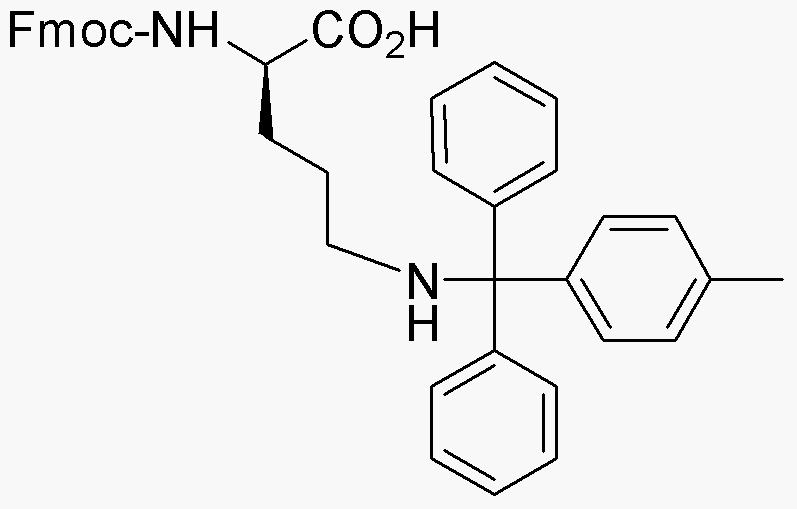Na-Fmoc-Nd-methyltrityl-D-Ornithine is widely utilized in research focused on:
- Peptide Synthesis: This compound serves as a key building block in the synthesis of peptides, particularly in solid-phase peptide synthesis. Its protective groups facilitate the stepwise addition of amino acids, ensuring high purity and yield.
- Drug Development: In pharmaceutical research, it is used to create peptide-based drugs. The ability to modify its structure allows researchers to design compounds with specific biological activities, enhancing therapeutic efficacy.
- Bioconjugation: The compound is employed in bioconjugation techniques, linking peptides to other biomolecules such as antibodies or enzymes. This application is crucial in developing targeted drug delivery systems.
- Research in Cancer Therapy: It has potential applications in cancer research, where modified peptides can be used to target cancer cells specifically, improving treatment outcomes while minimizing side effects.
- Protein Engineering: The compound is valuable in protein engineering, allowing scientists to create novel proteins with enhanced properties for various applications, including diagnostics and therapeutics.
Informations générales
Propriétés
Sécurité et réglementation
Applications
Na-Fmoc-Nd-methyltrityl-D-Ornithine is widely utilized in research focused on:
- Peptide Synthesis: This compound serves as a key building block in the synthesis of peptides, particularly in solid-phase peptide synthesis. Its protective groups facilitate the stepwise addition of amino acids, ensuring high purity and yield.
- Drug Development: In pharmaceutical research, it is used to create peptide-based drugs. The ability to modify its structure allows researchers to design compounds with specific biological activities, enhancing therapeutic efficacy.
- Bioconjugation: The compound is employed in bioconjugation techniques, linking peptides to other biomolecules such as antibodies or enzymes. This application is crucial in developing targeted drug delivery systems.
- Research in Cancer Therapy: It has potential applications in cancer research, where modified peptides can be used to target cancer cells specifically, improving treatment outcomes while minimizing side effects.
- Protein Engineering: The compound is valuable in protein engineering, allowing scientists to create novel proteins with enhanced properties for various applications, including diagnostics and therapeutics.
Documents
Fiches de données de sécurité (FDS)
La FDS fournit des informations de sécurité complètes sur la manipulation, le stockage et l’élimination du produit.
Spécifications du produit (PS)
Le PS fournit une description complète des propriétés du produit, notamment sa composition chimique, son état physique, sa pureté et les exigences de stockage. Il détaille également les plages de qualité acceptables et les applications prévues du produit.
Certificats d'analyse (COA)
Recherchez des certificats d'analyse (COA) en saisissant le numéro de lot du produit. Les numéros de lot et de lot se trouvent sur l'étiquette d'un produit, après les mots « Lot » ou « Lot de fabrication ».
Numéro de catalogue
Numéro de lot/série
Certificats d'origine (COO)
Ce certificat d'exploitation confirme le pays dans lequel le produit a été fabriqué, et détaille également les matériaux et composants utilisés et s'il est issu de sources naturelles, synthétiques ou autres sources spécifiques. Ce certificat peut être requis pour les douanes, le commerce et la conformité réglementaire.
Numéro de catalogue
Numéro de lot/série
Fiches de données de sécurité (FDS)
La FDS fournit des informations de sécurité complètes sur la manipulation, le stockage et l’élimination du produit.
DownloadSpécifications du produit (PS)
Le PS fournit une description complète des propriétés du produit, notamment sa composition chimique, son état physique, sa pureté et les exigences de stockage. Il détaille également les plages de qualité acceptables et les applications prévues du produit.
DownloadCertificats d'analyse (COA)
Recherchez des certificats d'analyse (COA) en saisissant le numéro de lot du produit. Les numéros de lot et de lot se trouvent sur l'étiquette d'un produit, après les mots « Lot » ou « Lot de fabrication ».
Numéro de catalogue
Numéro de lot/série
Certificats d'origine (COO)
Ce certificat d'exploitation confirme le pays dans lequel le produit a été fabriqué, et détaille également les matériaux et composants utilisés et s'il est issu de sources naturelles, synthétiques ou autres sources spécifiques. Ce certificat peut être requis pour les douanes, le commerce et la conformité réglementaire.


